
For Primary 5 and Primary 6, pupils learn the grammar rules for different sentence structures. This is to prepare for PSLE synthesis and transformation. One common type of sentence structure which routinely appears as a common PSLE synthesis and transformation question is the conversion of direct speech to reported speech.
Direct speech versus Reported speech
Direct speech refers to a person’s spoken words.
For reported speech, we change a person’s direct speech and re-write the direct speech using our own words.
Types of reported speech
PSLE synthesis and transformation questions focus on the following types of reported speech for statements, orders and questions.
For this post, we will examine the rules for the different types of reported speech , the grammatical rules and the common types of questions for PSLE synthesis and transformation.
A. Reported Statements
The first type of reported speech that we are introducing is the reported statement.
A reported statement is when someone speaks to you about something.
Pupils should take note that for reported statements, the rules to remember include:
- Change the pronouns
- Change the tense of the verb to show the change from direct to reported statement.
| Direct speech | Reported speech | |
| 1 | Present tense | Past tense |
| 2 | Present continuous tense | Past continuous tense |
| 3 | Past tense | Past perfect tense |
- Change the time
| Direct speech | Reported speech | |
| 1 | now | then |
| 2 | today | that day |
| 3 | tomorrow | the following day |
| 4 | this morning | that morning |
| 5 | next week | the following week |
| 6 | yesterday | the previous day |
| 7 | last week | the previous week |
How to write a reported statement

A reported statement generally starts with the speaker and the speech verb. This part of the answer is generally given.
Max said that …
First, the pronoun is also written to show the speaker.
Max said that he ….
Next, the pronoun is also changed to show the speaker.
Max said that he ….
After that, the verb is changed to show that the reported statement took place in the past.
Max said that he was going …
Then pupils have to consider if they have to change the place. In this case, there is no need to do so.
Max said that he was going to the beach…
Finally, change the time according to the rules for reporting statement.
Max said that he was goingto the beach the following day.
Now, we’ll examine two common types of questions for reporting statements.
Reported statement question 1

The first type of reported statement requires pupils to make the following changes – Change the pronoun, tense of the verb and the time.

Reported statement question 2

The second type of reported statement requires pupils to make changes to the pronoun and the time.
Pupils should note to change the verb from the past tense to the past perfect tense for reported speech.
This is also the more commonly-tested question type for PSLE Synthesis and Transformation.
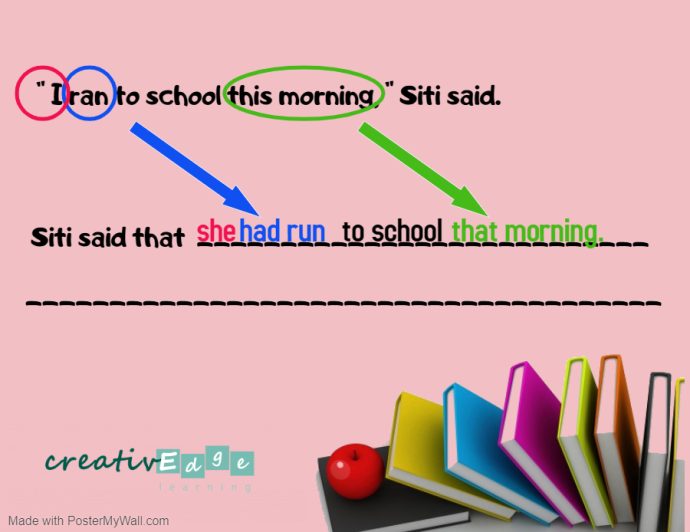
It is also more a more common PSLE synthesis and transformation question as the change from past tense to past perfect tense is slightly more challenging.
B. Reported orders
Another type of reported speech is reported orders. This is when someone tells you to do something.
It is like an order as you must listen to the person’s words and follow his order.
How to write a reported order
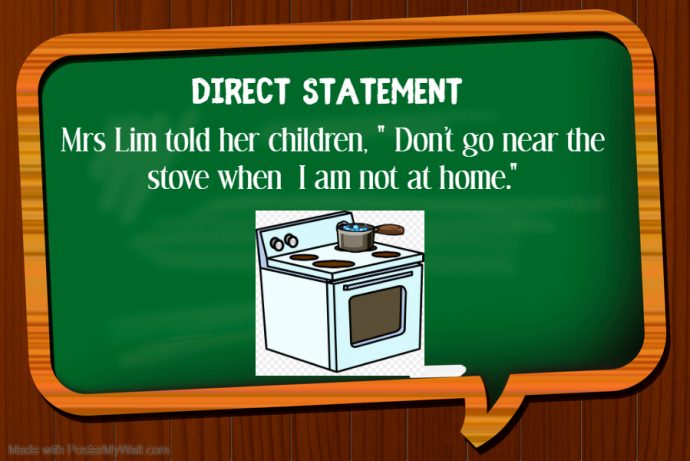
A reported order generally starts with the speaker and the speech verb. As it is an order, the speech verb is usually “told”.
The first part of the answer is usually given.
Mrs Lim told her children …
The “don’t” in direct speech must be changed to “not to” for reported orders.
Mrs Lim told her children not to …
Next, to add the noun that does not require any changes.
Mrs Lim told her children not to go near the stove when …
For reported orders, the tense of the verb must be changed too.
The rules for change of pronouns and tenses are the same as those of reported statements.
In this case, change the pronoun “I” to “she” as the speaker is Mrs Lim. In addition, change the tense of the verb from present (is) to past tense (was).
Mrs Lim told her children not to go near the stove when she was not at home.
Now that we have explained the steps for writing a reported order, let’s look at two common questions for reported orders.
Reported order Question 1
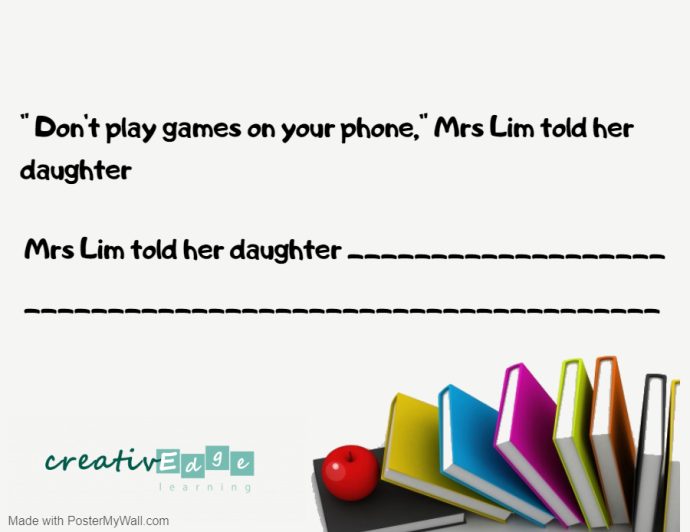

Reported order Question 2
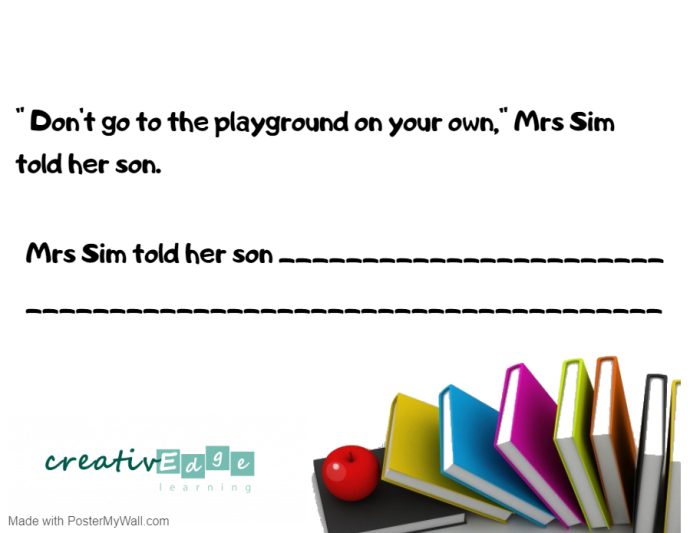

C. Reported Questions
Another type of reported speech is reported questions when the speaker asks a question.
How to write a reported question
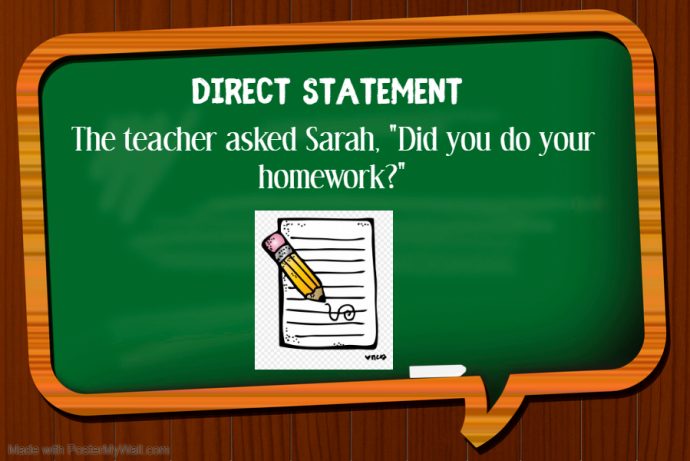
A reported question generally starts with the speaker and the speech verb. As it is an question, the speech verb is “asked”.
The teacher asked Sarah …
For such reported questions which the answer is yes or no, pupils should start with if.
The teacher asked Sarah if …
Next, the pronoun must be changed too.
The teacher asked Sarah if she…
Like reported statements and orders, the verb has to be changed using the same rules.
The keyword is “Did” which shows that the direct question is in the past tense. As such, the reported question has to be in the past perfect tense. For PSLE synthesis, the focus is generally on the change from past tense to past perfect tense.
For reported questions, it is important to note that the re-order of certain words too.
For a reported question, the direct question is changed to read like a statement. Therefore, instead of “Had she done”, it should be “she had done”
The teacher asked Sarah if she had done…
Finally, pupils must remember the basic rule of synthesis and transformation. Pupils must use as many of the words in the question as possible in the answer.
The teacher asked Sarah if she had done her homework.
Next, let’s look at two questions for reported questions.
Reported question Question 1
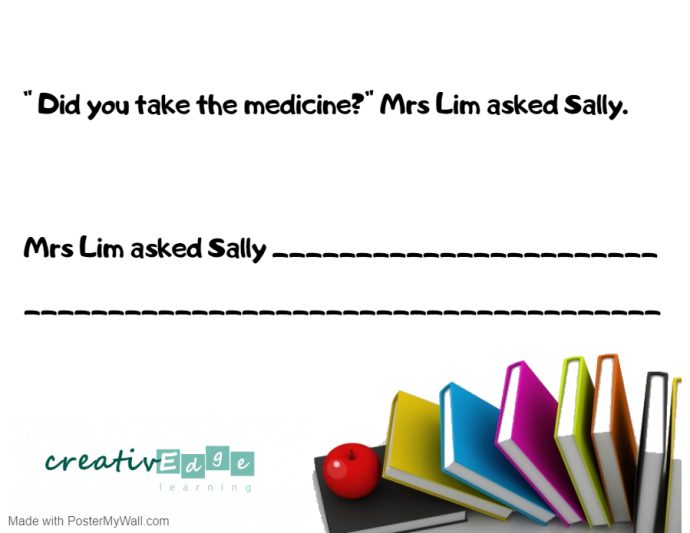
As clearly shown in the answer below, the past tense is changed to past perfect tense. The words are also re-ordered to read like a statement.

Reported question Question 2
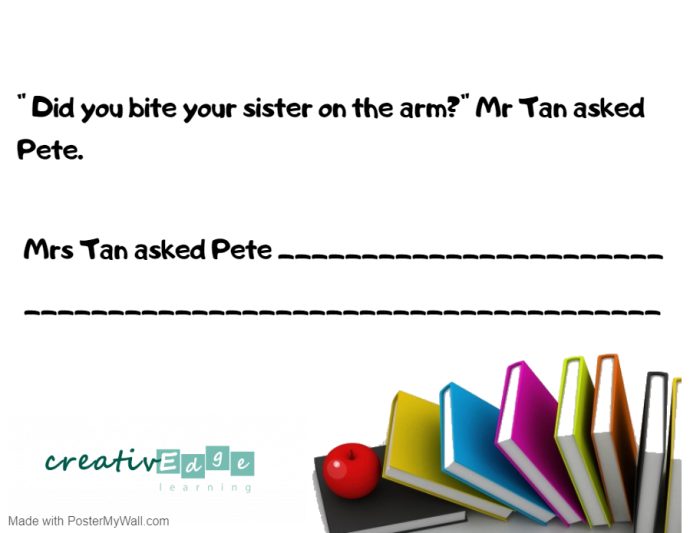

D. Direct speech
For the last section, we are focusing on a newer type of PSLE synthesis and transformation question is the change from reported speech to direct speech.
How to write direct speech
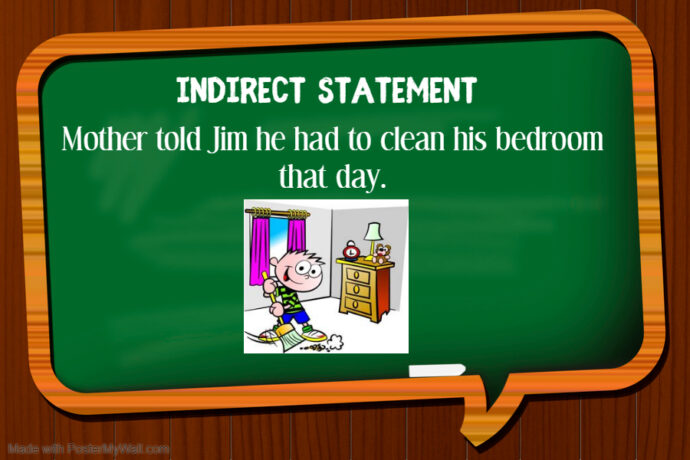
For direct speech, the first part of the answer is usually given.
Mother told Jim, …
For direct speech questions , pupils have to take note of the punctuation. The direct speech must start with an open-inverted comma.
Mother told Jim, “…
Like reported speech, the pronouns must be changed.
Mother told Jim, “You………… your…
When writing direct speech, pupils should take note of the modal verbs. In this case, “had to” is changed to “must”
Mother told Jim, “You must….. your…
For direct speech, pupils also have to consider the change of the tenses for the verbs. In addition, pupils should pay attention to the modal verbs and if it requires a change.
| Direct speech | Reported speech | |
| 1 | can | could |
| 2 | may | might |
| 3 | must | had to |
| 4 | should | should |
| 5 | might | might |
| 6 | could | could |
| 7 | will | would |
In this case, there is a modal verb “must” so the verb accompanying it has to be in the present tense.
Mother told Jim, “You must clean… your…
Next, the noun remains unchanged.
Mother told Jim, “You must clean your bedroom…
Then pupils have to change the time. The same rules apply as that of reported speech.
Mother told Jim, “You must clean your bedroom today…
Lastly, pupils must remember the punctuation for direct speech.
In this case the direct speech must be ended with a full stop and a close-inverted comma.
Mother told Jim, “You must clean your bedroom today.”
Let’s examine two questions to learn how to convert a reported statement to a direct statement.
Direct Speech Question 1
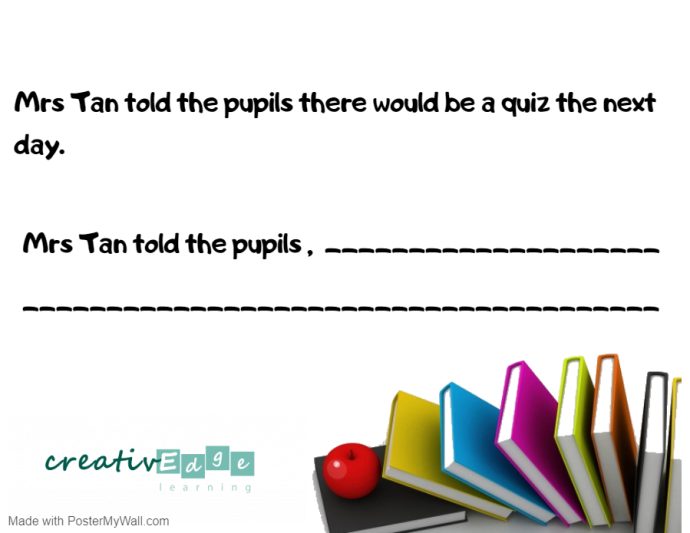

Direct speech Question 2


Also, do read our top 10 most common exam themes for the PSLE composition exam as well as our top exam tips for the PSLE composition exam.



